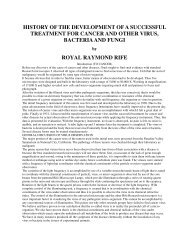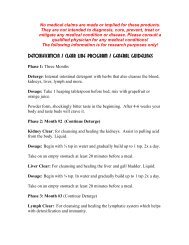TrueRife Diagnostic Program / CleanUpRunMeFirst
TrueRife Diagnostic Program / CleanUpRunMeFirst
TrueRife Diagnostic Program / CleanUpRunMeFirst
Create successful ePaper yourself
Turn your PDF publications into a flip-book with our unique Google optimized e-Paper software.
Strongyloides stercoralis is an unusual "parasite" in that it hasboth free-living and parasitic life cycles. In the parasitic lifecycle, female worms are found in the superficial tissues of thehuman small intestine; there are apparently no parasitic males.The female worms produce larvae parthenogenically (withoutfertilization), and the larvae are passed in the host's feces. Thepresence of nematode larvae in a fecal sample is characteristic ofstrongylodiasis. Once passed in the feces, some of the larvae develop into "freeliving"larvae, while others develop into "parasitic" larvae. The "free-living" larvaewill complete their development in the soil and mature into free-living males andfemales. The free-living males and females mate, produce more larvae, and (asabove) some of these larvae will develop into "free-living" larvae, while other willdevelop into "parasitic larvae." As one might imagine, this free-living life cycleconstitutes an important reservoir for human infections.The "parasitic" larvae infect the human host by penetrating the skin The larvaemigrate to the lungs, via the circulatory system, penetrate the alveoli into the smallbronchioles, and they are "coughed up" and swallowed. Once they return to thesmall intestine, the larvae mature into parasitic females.Ascaris lumbricoides is one of the largest and most commonparasites found in humans. The adult females of this species canmeasure up to 18 inches long (males are generally shorter), andit is estimated that 25% of the world's population is infected withthis nematode. The adult worms live in the small intestine andeggs are passed in the feces. A single female can produce#up to 200,000 eggs eachday! About two weeks after passage in the feces the eggs contain an infectivelarval or juvenile stage, and humans are infected when they ingest such infectiveeggs. The eggs hatch in the small intestine, the juvenile penetrates the smallintestine and enters the circulatory system, and eventually the juvenile worm entersthe lungs. In the lungs the juvenile worm leaves the circulatory system and entersthe air passages of the lungs. The juvenile worm then migrates up the air passagesinto the pharynx where it is swallowed, and once in the small intestine the juvenilegrows into an adult worm. Why Ascaris undergoes such a migration through thebody to only end up where it started is unknown. Such a migration is not unique toAscaris, as its close relatives undergo a similar migration in the bodies of theirhosts (view diagram of the life cycle).#Ascaris infections in humans can cause significant pathology. The migration ofthe larvae through the lungs causes the blood vessels of the lungs to hemorrhage,













